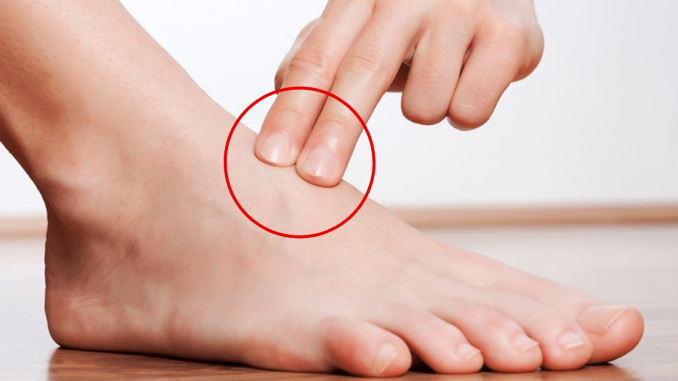
Imagine walking up stairs and suddenly feeling intense leg pain that forces you to stop. This isn’t just muscle fatigue – it could be your body’s urgent warning about a condition that affects millions. In fact, 50% of people with this disease don’t even know they have it, and by the time symptoms appear, their arteries may already be 60% blocked.
In this video, we’ll dive deep into what’s really causing that mysterious leg pain – Peripheral Arterial Disease, or PAD – a serious condition where fatty deposits (plaque) build up in your leg arteries, reducing blood flow to your legs and feet. We’ll reveal 10 warning signs that most people miss, explain why this condition affects 12% to 20% of Americans over 60, and nearly 50% of those 85 and older, and share the crucial steps you need to take to protect your arterial health.
Whether you’re in your 40s, 50s, or beyond, understanding these silent signals could literally save your life or limb. We’ll explore how everyday habits contribute to artery clogging, the simple tests your doctor can use to diagnose PAD, and most importantly, the proven lifestyle changes that can help reverse this condition before it’s too late.
From understanding your risk factors to learning which foods clear your arteries naturally, we’ll equip you with the knowledge you need to take control of your vascular health. Stay tuned as we uncover the hidden signs your body might be sending you right now.
First, let’s explore what actually causes PAD.
Over 90% of cases stem from atherosclerosis – where plaque builds up inside your arteries, creating a dangerous cascade effect in your body. This plaque progressively narrows your arteries, making vessel walls stiffer and significantly reducing crucial blood flow to your legs.
Perhaps most concerning is that these buildups can form blood clots that further block circulation – if these clots break off and travel through the bloodstream, they can cause a heart attack if they reach the heart, or a stroke if they reach the brain’s arteries, creating life-threatening situations
PAD can also develop through several other mechanisms. Blood vessel inflammation, known as vasculitis, can cause vessel walls to thicken and scar. Physical traumas, including fractures and surgical procedures, can damage blood vessels and lead to PAD. Some people develop the condition from radiation exposure, particularly during cancer treatments, while others may have irregular blood vessel formation present since birth.
But here’s what’s really shocking about PAD – certain lifestyle factors and conditions can dramatically increase your risk. Smoking stands out as the single most dangerous contributor, increasing risk by 400%. Other significant risk factors include diabetes (especially Type 2), high blood pressure, and abnormal cholesterol. Age plays a crucial role, with risk climbing sharply after 65. Chronic kidney disease and a family history of cardiovascular disease also significantly increase your chances of developing PAD.
What makes these risk factors particularly dangerous is their synergistic effect – they don’t just add up, they multiply. Having three or more risk factors can increase your PAD risk by a factor of ten.
This multiplication effect helps explain why PAD is rarely an isolated condition. When plaque builds up in your leg arteries, it’s usually a sign of systemic atherosclerosis, meaning other arteries throughout your body are likely affected as well.
Now that you understand the devastating impact of PAD and how risk factors multiply its danger, let’s examine these ten warning signs – your body’s desperate cry for help. Some are subtle, others dramatic, but all deserve your immediate attention.
Let’s begin with the most common signal: intermittent claudication – that same leg cramping we mentioned earlier that forces you to stop walking or climbing stairs.
Unlike normal muscle fatigue, this pain has a distinct pattern: it strikes during activity and quickly subsides with rest. It’s your muscles crying out for more blood flow.
Moving to our second sign, we see persistent leg numbness and weakness.
This isn’t normal aging – it’s an ongoing sensation affecting your feet and leg muscles, signaling that blood flow has been significantly reduced.
The third warning sign reveals something many people overlook: temperature differences in your legs and feet.
If one leg feels notably colder than the other, or your feet feel cold compared to the rest of your body, it’s a clear signal that blood isn’t reaching these areas effectively.
Your skin tells the fourth story.
PAD can cause your legs to develop a shiny, smooth texture, often taking on pale, bluish, or purplish tones – all signs that your skin isn’t getting the blood supply it needs.
Here’s a surprising fifth sign that most people overlook: increased hair loss on your feet and legs.
Those ‘balding toes’ aren’t just cosmetic – they’re telling you that blood flow has become so restricted it can’t even sustain normal hair growth.
The sixth sign is subtle but significant: changes in your toenails.
When they become brittle and grow unusually slowly, it’s another sign that reduced blood flow is affecting your body’s normal functions.
Now we’re entering more serious territory with our seventh sign: non-healing sores on your feet or legs.
These stubborn ulcers that refuse to heal are red flags that demand immediate attention – if left untreated, they can lead to dangerous complications like gangrene, and even amputation.
As we move into advanced warning signs, number eight is something your doctor will check: weak or absent pulses in your feet and ankles.
While you might not notice this yourself, it’s a crucial indicator during medical examinations.
The ninth sign signals advanced PAD: pain even at rest – a burning sensation in your feet that typically worsens at night or when you elevate your legs.
This pain, occurring without any physical activity, means your arteries are severely narrowed. This can progress to Critical Limb Ischemia (CLI), where blood flow becomes so restricted that tissue death becomes a real risk.
Our final warning sign, particularly concerning in men with diabetes, is erectile dysfunction.
While it might seem unrelated to leg arteries, it often signals the same underlying problem – restricted blood flow throughout your body.
Remember: PAD is a silent threat – half of those affected show no symptoms at all. Don’t wait for multiple warning signs to appear. If you spot even one of these signals, especially with risk factors like smoking or diabetes, seek medical help immediately. Your quick action could save more than just your legs.
Your doctor begins with a physical exam – checking your skin, feeling for pulses, and listening to blood flow with a stethoscope. But the real game-changer is a simple test called the ankle-brachial index, or ABI. Think of it as a tale of two blood pressures: your doctor compares pressure readings between your ankles and arms. In healthy arteries, these numbers match. A significantly lower ankle pressure? That’s PAD raising its red flag.
When needed, doctors can look deeper with advanced imaging – from ultrasounds that peek inside your arteries to special X-rays called angiograms that map out exactly where blockages lurk.
Once you’ve been diagnosed with PAD, there’s good news: you can take control starting today.
Your daily choices can help stop and even reverse artery damage.
Walking is your secret weapon. Start with an exercise program, alternating between walking and resting periods. While it might feel uncomfortable at first, just 30 minutes daily can dramatically increase your walking distance and transform your circulation. Cycling and swimming are great alternatives to walking.
Your diet plays a crucial role in healing your arteries. Think of your plate as medicine: fill half with colorful vegetables and fruits packed with natural antioxidants that fight inflammation—the root of artery damage and heart disease.
Modern diets sabotage arteries in three key ways: hidden sugars in processed foods, appearing as high-fructose corn syrup, dextrose, and maltodextrin; industrial seed oils, like canola, soybean, corn, sunflower, and safflower oil; and highly processed grains stripped of nutrients, found in refined cereals and packaged snacks. These culprits are rampant in ultra-processed foods. Eliminate items like soft drinks, packaged snacks, sweetened cereals, ready-to-eat meals, frozen desserts, and processed meats. Studies show these foods increase inflammation and can raise your risk of cardiovascular disease by up to 50%.
When it comes to healing foods, start with healthy fats like olive oil, avocado oil, and fatty fish like wild-caught salmon, sardines, and mackerel. Omega-3 fatty acids from these fish help lower triglycerides, reduce blood pressure, and stabilize atherosclerotic plaques. They also provide anti-inflammatory benefits and help prevent blood clots while improving heart function.
Add protein power through grass-fed meat (rich in omega-3s compared to grain-fed beef) and pasture-raised eggs (packed with choline, vitamin D3, and eye-protecting antioxidants). Choline helps regulate blood pressure, improves cardiac function, and protects against cardiovascular damage by reducing inflammation. Boost gut health with fermented foods like kefir, natto, and sauerkraut—their vitamin K2 fights arterial calcification. Enhance flavor and circulation with anti-inflammatory spices like turmeric and garlic, paired with plenty of water to flush toxins and maintain blood flow.
For additional support, consider supplements like this nutrient-rich powder containing 8 key nutrients, including vitamin K2, clinically shown to boost blood flow and combat plaque. But remember: Supplements are just one piece of the puzzle.
Your greatest power lies in avoiding harmful foods entirely and embracing lifestyle changes: quit smoking—it’s your most impactful move; maintain a healthy weight to reduce strain on your arteries; protect your feet from extreme temperatures; avoid cold medications that restrict blood flow; and work with your doctor on medications for clots, cholesterol, or circulation—they’re backup support for your efforts.
Here’s the most powerful truth about PAD: Every positive choice you make starts healing your arteries immediately. The power to transform your health isn’t in some distant future—it’s in your very next decision. Ready to take that first step? Download your free anti-inflammatory diet plan below and start rebuilding your circulatory health today.



